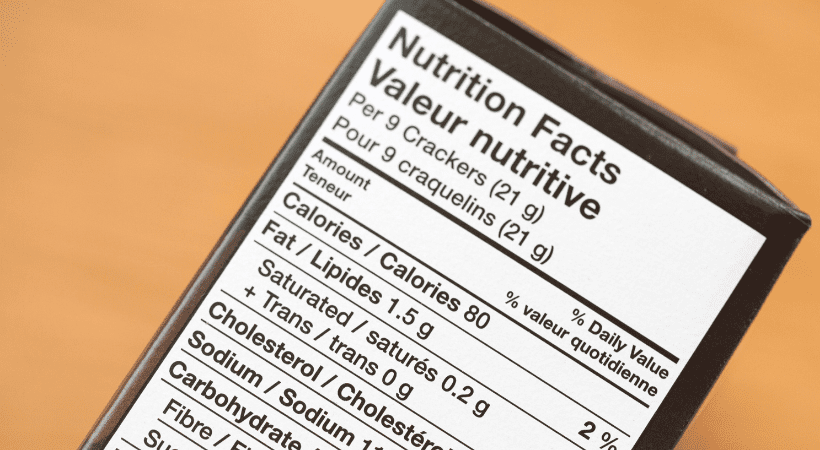PEAL Food Allergen Labelling Australia: A Complete Guide to the New Legal Requirements
PEAL Food Allergen Labelling Australia: A Complete Guide to the New Legal Requirements
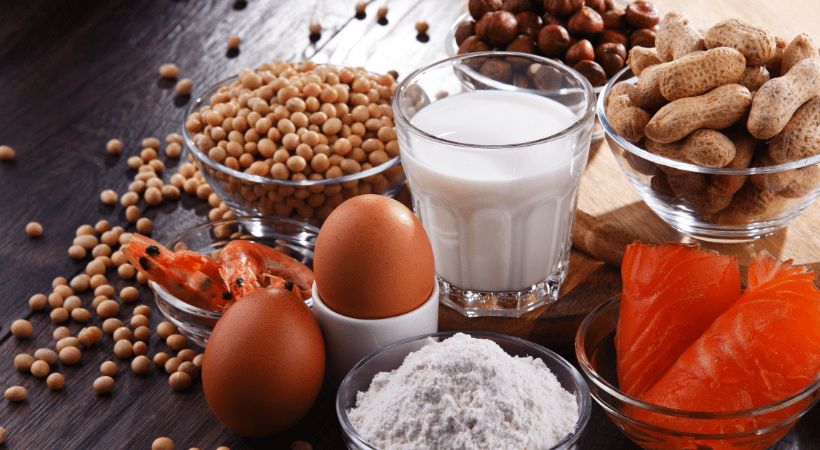
What is PEAL Labelling?
If you export foods to be sold in Australia and New Zealand, you need to comply with the Australia New Zealand Food Standards Code (ANZFSC), which includes all requirements for allergen declarations.
On 25th February 2021, changes were introduced into law via the ‘Plain English Allergen Labelling’ – ‘PEAL’ – amends to ANZFSC. The requirements can be found in ANZFSC Std 1.2.3 and Schedule 9.
In this article, Dr Janine Curll, Regulatory Manager at Ashbury Australia, summarises the new legal requirements to assist food businesses in updating food and beverage labels and achieving compliance before the end of the PEAL transition period.
Table of Contents
- Why is PEAL Labelling being introduced?
- What changes will food manufacturers have to make to their allergen labelling?
- Terminology for allergens that have changed
- What products does PEAL apply to?
- Are there any exemptions to PEAL?
- What was the transition period?
- What about PAL and other allergen labelling?
- Expert tips to help you comply with PEAL regulations
Why is PEAL Labelling being introduced?
Allergen labelling is essential to consumers and is arguably the most important aspect of a food product’s labelling. Allergenic consumers rely on this product information to determine whether food is safe and suitable for consumption. There have been many incidences over the years, with consumers facing serious injury and death due to incomplete or unclear allergen information.
The PEAL updates aim to improve allergen information provision by presenting the prescribed allergens in plain English, creating a consistent and easily understood format across food labels that makes it easier for consumers to read and understand.
What changes will food manufacturers have to make to their allergen labelling?
The new requirements can be considered under 3 main categories of changes:
- Location
- Format
- Terminology
Location – Packaged Food
New requirements for the location of the Statement of Ingredients and Summary Statement are specified in the new legislation:
(1) The Statement of Ingredients must declare allergen required names for each ingredient.
(2) Allergens in processing aids must now be declared at the end of the Statement of Ingredients.
(3) Distinctly separate summary statements must be within the same field of view.
The illustration below represents the distinctly separate summary of ingredients. This statement can be to either side, above or below the Statement of Ingredients.
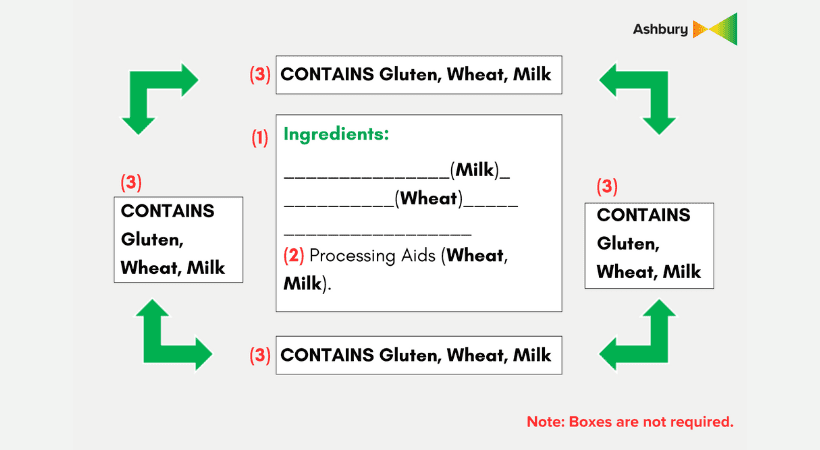
Format – Packaged Foods
The Statement of Ingredients allergen declarations:
(4) Must be in bold font.
(5) The bold font must contrast distinctly with all other text within the ingredients list.
(6) The type size for bold declarations must be no less than that of the other text.
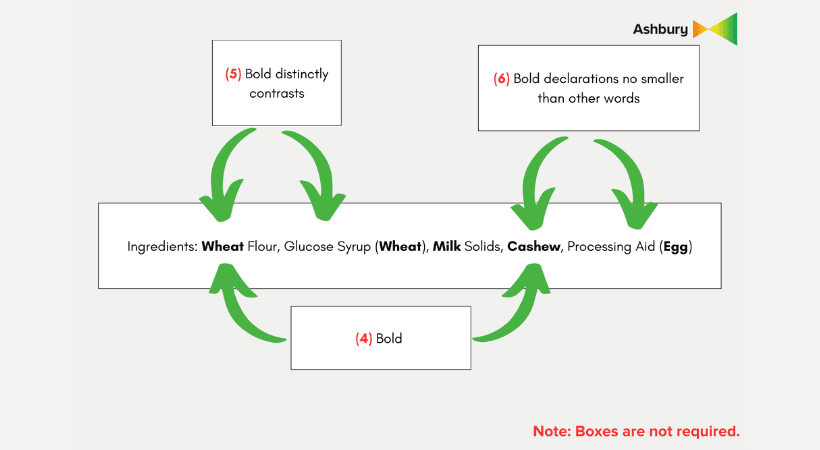
The Summary Statement:
(7) Must be in bold font (including ‘contains’) and should contrast distinctly with other text in the Statement of Ingredients.
(8) The size of type and font must be the same for the declarations in the Statement of Ingredients.
(9) Must contain no other words or allergens not required for Australia.
Example
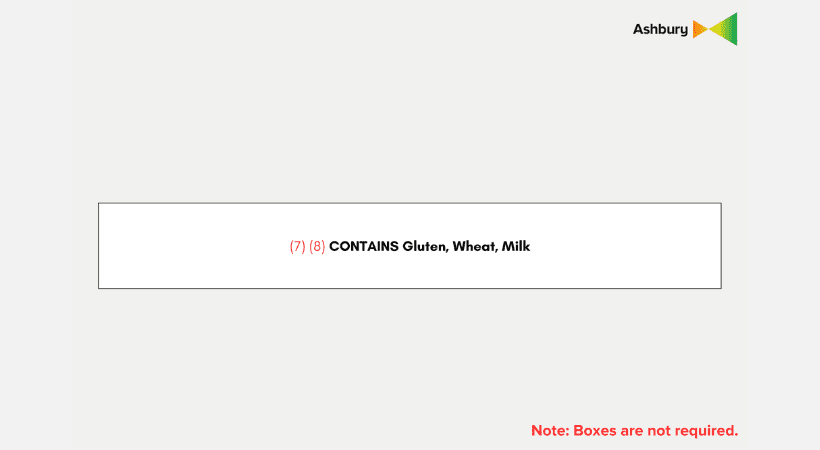
Terminology – Packaged Foods
‘Required names’, as per Schedule 9, must be used (see Table B below). Some ‘required names’ differ between the Statement of Ingredients and the Summary Statement. For example, Gluten is included in the Summary Statement but not in the Statement of Ingredients when declaring a gluten-containing cereal such as wheat. Required names are also acceptable in either plural or singular format.
Terminology for Allergens that have changed
Previously, ‘tree nuts’ could be used to declare the presence of any tree nut. This is no longer acceptable. Each nut name must be used when the tree nut is one of the nine included for declaration: almond, Brazil nut, cashew, hazelnut, macadamia, pecan, pine nut, pistachio and walnut.
There are also changes to soybean, cereals containing gluten, and molluscs which have been added as a required name for declaration.
Table A
| OLD | NEW |
| ‘Tree nuts’ | Almond, Brazil nut, cashew, hazelnut, macadamia, pecan, pine nut, pistachio, walnut (no other tree nuts need to be declared) |
| ‘Soybeans’ | Statement of Ingredients: Soybean, Soy or Soya |
| Summary Statement: ‘Soy’ only | |
| Cereals containing gluten | Statement of Ingredients: Wheat Barley, Rye, Oats |
| Summary Statement: Wheat, Gluten (for the presence of wheat) Gluten (for the presence of barley, rye, oats) | |
| Fish Crustacea | Fish Crustacean Mollusc |
Table B: Required names (allergens for declaration in Australia)
| Required name for declaration in Statement of Ingredients | Contains statements |
| Sulphites Barley Oats Rye Wheat Almond Brazil nut Cashew Hazelnut Macadamia Pecan Pine Nut Pistachio Walnut Crustacean Egg Fish Lupin Milk Mollusc Sesame Soy, soya or soybean | Sulphites Gluten Wheat Almond Brazil nut Cashew Hazelnut Macadamia Pecan Pine Nut Pistachio Walnut Crustacean Egg Fish Lupin Milk Mollusc Sesame Soy |
No brand new allergens for declaration have been introduced, however how they are labelled has changed.
What products does PEAL apply to?
PEAL labelling requirements apply to all general foods and beverages required to bear a label and intended to be sold via retail in Australia and New Zealand.
Are there any exemptions to PEAL?
Two specific food categories – Foods for Special Medicinal Purposes and Infant Formula for Special Dietary Use – are expressly exempt for PEAL. Labels on products in these categories must continue to declare allergens with existing declarations.
Additionally, retail food not required to bear a label, food sold to caterers and food exempt from possessing a statement of ingredients (such as small packages, single-ingredient foods and individual portion packets), must declare allergens using the required names (listed in Table B above), but they are exempt from the location and formatting requirements.
Please note, the pre-PEAL allergen labelling exemptions for specific substances where processing render these substances safer for people with allergies have not changed. Where the conditions in the regulations are met, the substances continue to be exempt from declarations (see: Schedule 9-3 table, column 2). Food businesses are reminded to ensure they have the information necessary to determine the exemptions that apply to the foods and substances used.
What was the transition period?
The transition period for compliance with PEAL ends 24th February 2024. Food businesses should be implementing plain English allergen declarations on their food labels now. Foods already produced and labelled with existing declarations before the end of the transition period can be legally sold for a further two years (until 24th February 2026). Any food placed on the market for sale after the 24th February 2024, must comply with PEAL regulations.
What about PAL and other allergen labelling?
PEAL does not incorporate Precautionary Allergen Labelling. PALs remain voluntary statements.
We at Ashbury recommend that the Allergen Bureau’s VITAL is used to determine the correct allergen labelling for both CONTAINS and MAY BE PRESENT statements.
Expert tips to help you comply with PEAL regulations:
Food businesses are encouraged to ensure all three categories of changes discussed above, are applied to each label used on food for sale in Australia and New Zealand.
Here are some examples of common challenges we have seen and recommend that companies watch out for:
- Bolding the word ‘ingredients’ at the start of the Statement of Ingredients
- Using tree nuts when individual nut names (the nine allergenic nuts) are now required
- Not using the required name as set out in Schedule 9
- Not bolding all instances of the required name in the Statement of Ingredients
- Including allergens for declaration in other markets (e.g. celery, coconut, mustard)
- Inconsistency in the size of text between the bolded required name in the Statement of Ingredients and the bolded required name in the Summary Statement.
The resources required to adapt to regulatory changes can cause unnecessary pressure for already busy technical teams. As experts in food labelling compliance Ashbury can offer flexible support to help you tackle the additional work that PEAL regulations are creating for your business.
If you export food products to Australia or New Zealand and require any further information or assistance with PEAL, get in touch with our team today.
Next reads
The Peanut Diaries: School and Social Occasions
The Peanut Diaries: Navigating Social Events and Celebrations with Food Allergies
The Peanut Diaries: A Parent’s Journey to Uncovering their Child’s Allergy
Redefining Healthy: What the FDA’s New Rules Mean for Food Labels and Nutrition Claims
Keep up to date with our latest insights
Subscribe to our mailing list to stay in touch with the latest news, insights and updates from Ashbury





